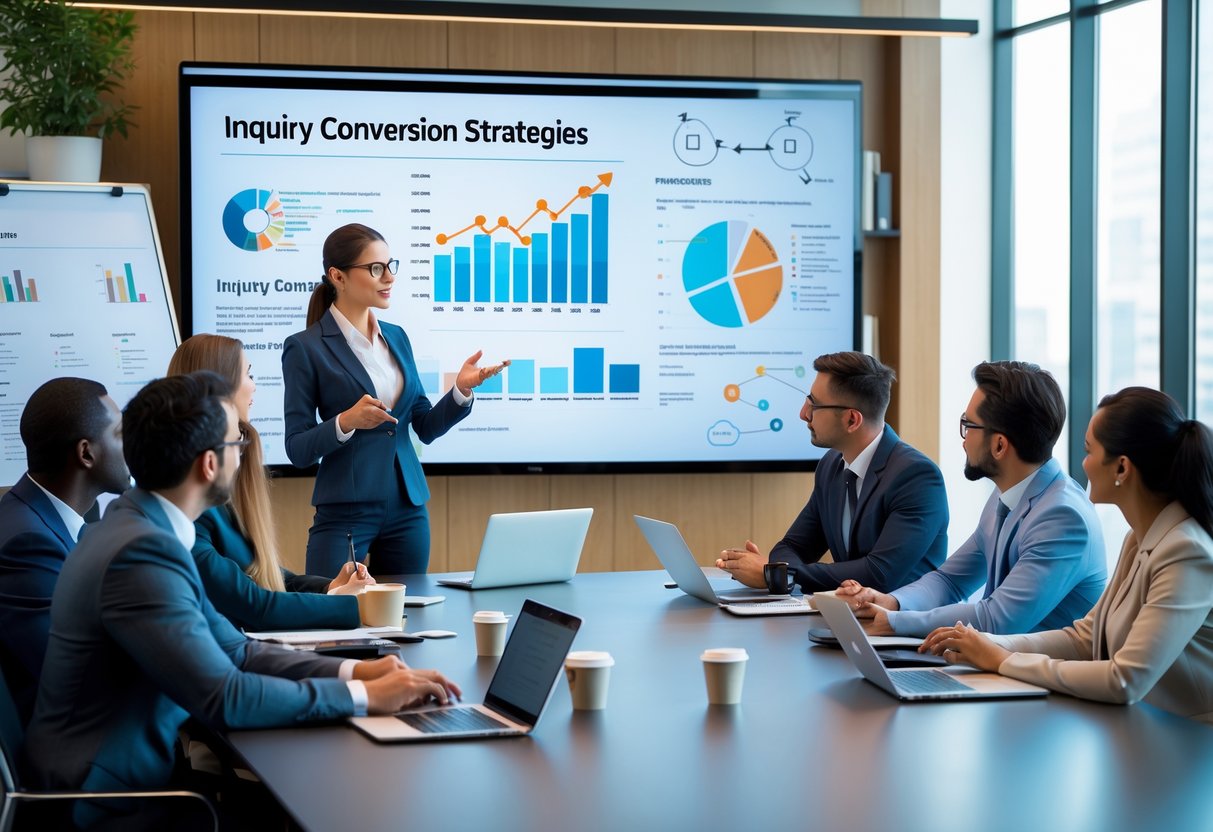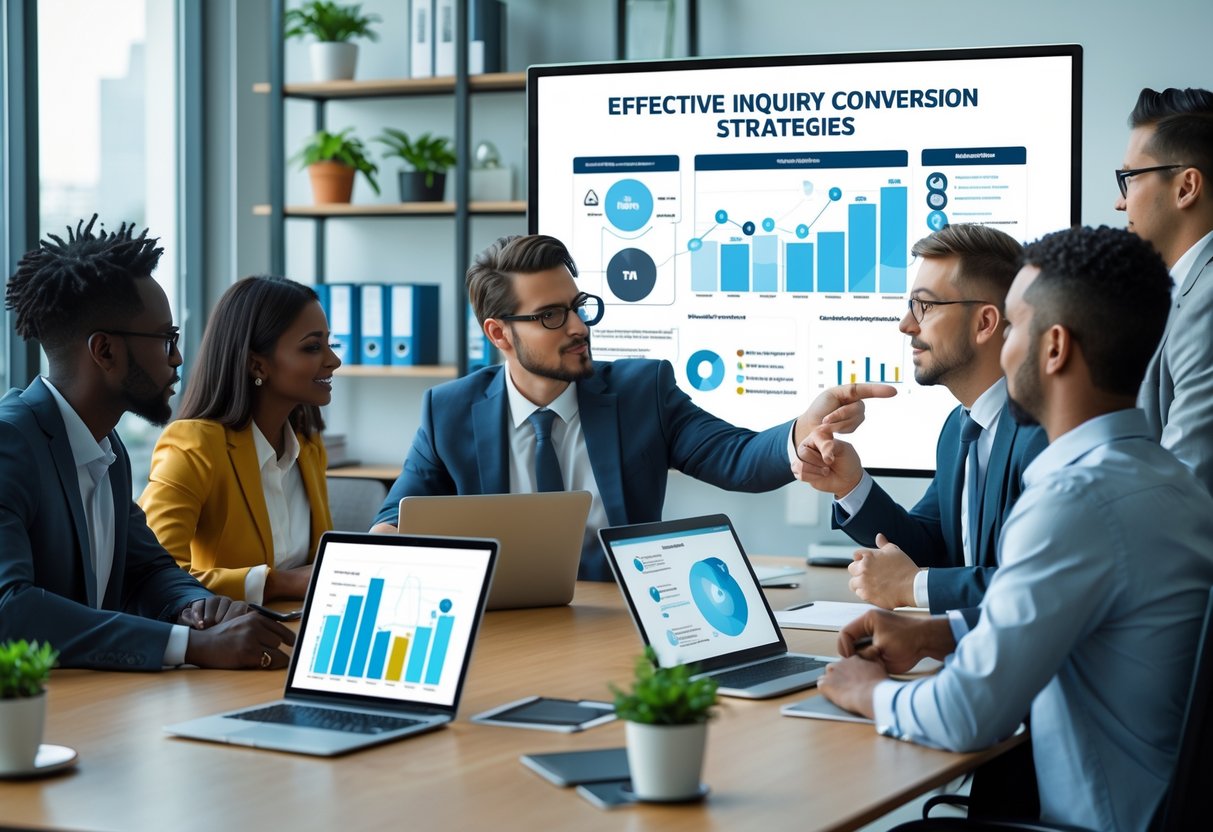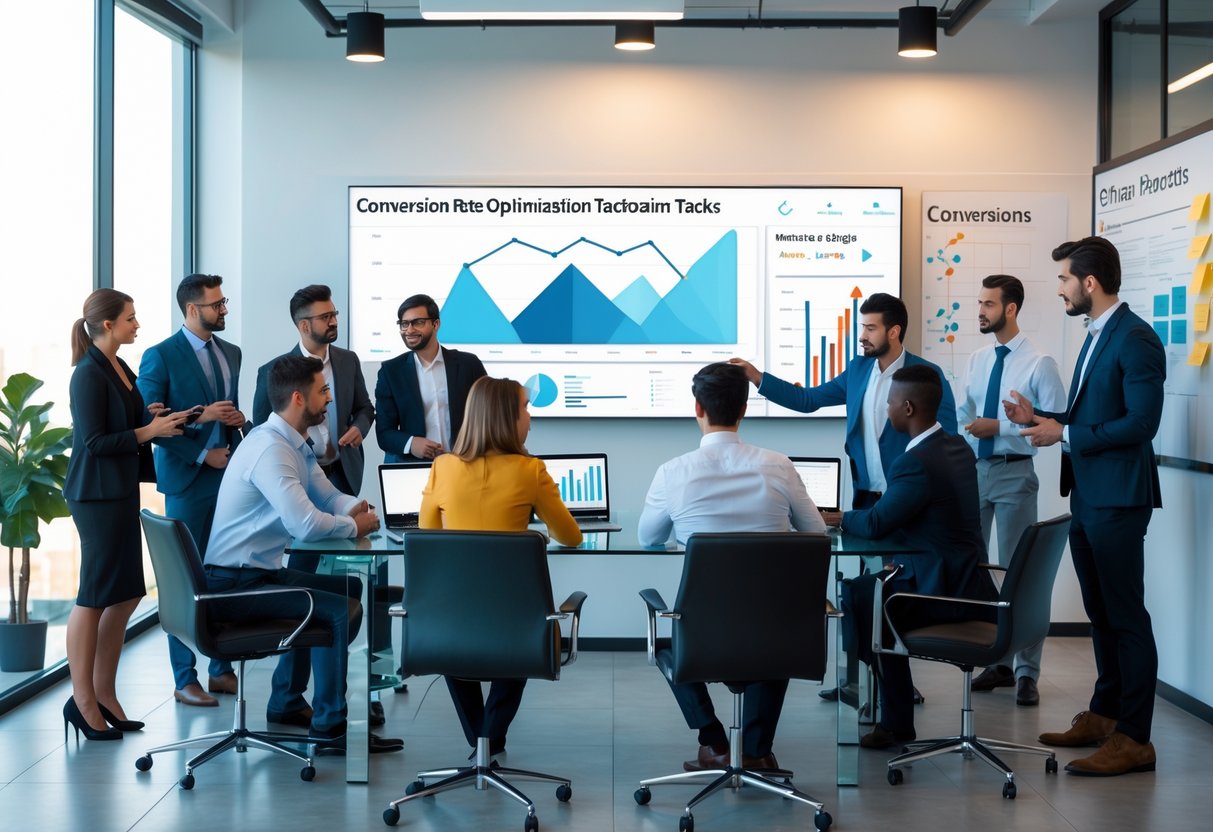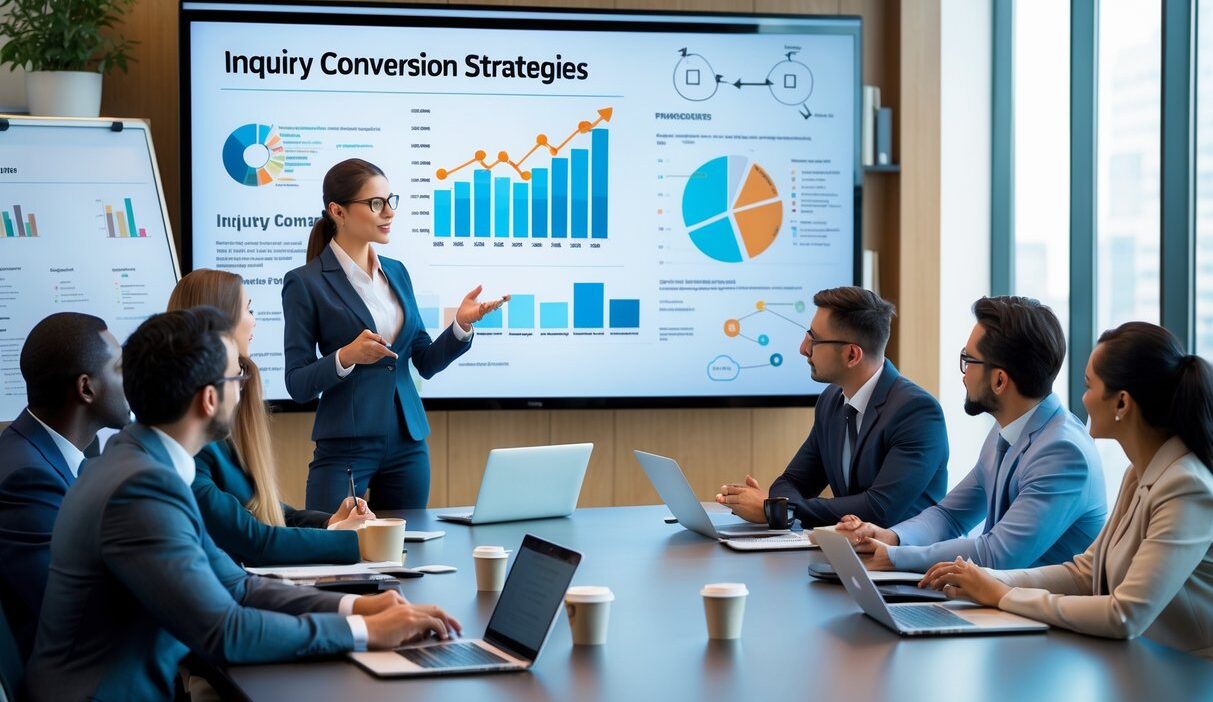Turning an inquiry into a real application isn’t just about luck. You need clear communication, a steady follow-up, and a process that makes the next step feel easy.
The best inquiry conversion strategies take down barriers, build trust, and nudge people smoothly from “I’m interested” to “I’m in.”

I spend a lot of time on strategies that don’t just grab attention but actually keep things moving. When communication feels personal and quick, inquiries tend to go somewhere instead of fizzling out.
Small tweaks in your outreach, clarity, and support can really add up in your conversion rates.
When you mix tried-and-true tactics with a little data-driven insight, you spot what’s working and what’s just noise. This way, you give every inquiry its best shot at becoming a real application, and you don’t waste your time or money.
Key Takeaways
- Clarity, trust, and a super easy process are the backbone of strong conversion strategies
- Data and tech help spot leaks and boost your numbers
- Personalized, regular communication makes people more likely to apply
Understanding Inquiry Conversion Strategies
I like to break down how inquiries move through the admissions process and why conversion rates matter. Each stage of the funnel tells you something about what’s working or stalling.
What Is Inquiry Conversion?
When I say inquiry conversion, I’m talking about turning that first sign of interest—maybe a form submission, an email, or just a chat at an event—into a completed application. It’s that moment someone actually takes the next step.
If 100 people ask about your service and 20 apply, you’ve got a 20% conversion rate. Simple math, but it tells you a lot.
This is the first real hurdle in the admissions funnel. If you don’t have a good system to move people forward, everything else gets harder. Schools that use structured communication and clear instructions usually see better results, as shown in admissions funnel optimization tips.
Importance of Conversion Rate
The conversion rate tells me how well the admissions team turns curiosity into real action. High rates mean your process is clear and inviting. Low rates? That’s usually a sign something’s off—maybe slow replies or unclear steps.
Tracking this number lets me spot issues early. If hardly anyone applies after inquiring, I know the problem is right at the top.
I also use conversion rates to check if new tactics work. Maybe you add personalized emails or student ambassador calls—if your numbers go up, you know you’re onto something. Schools that analyze their conversion funnel data often find that even small tweaks make a difference.
Stages of the Conversion Funnel
Here’s how I see the funnel, step by step:
- Inquiry – someone shows interest
- Applicant – they submit the application
- Candidate – all materials are in
- Admit – you offer admission
- Scheduled – classes get assigned
- Enrolled – the student actually starts
Each stage has its own drop-off rate. If you notice a big dip at any stage, that’s your cue to fix something—maybe clearer instructions or better follow-up. More details in this admissions funnel guide.
Key Elements of Effective Inquiry Conversion

I want it to be super easy for people to understand what I offer, who I’m here for, and what I want them to do next. Clear communication, smart outreach, and spot-on calls to action are the foundation.
Defining Your Value Proposition
I make sure my value proposition spells out exactly why you should buy from me instead of someone else. It’s not just “great service”—I tell you how I deliver faster results or more value.
Vague promises don’t cut it. I go for direct, measurable statements.
I keep this message the same across my site, emails, and conversations. If I start changing it up, people get confused and trust drops.
I like to test different messages and see which one actually gets more people to convert. It’s a bit of trial and error, but it works.
Identifying and Segmenting Your Target Audience
Trying to convert everyone the same way just doesn’t work. I start by figuring out who’s who—maybe by age, interest, or how close they are to buying.
Segmentation lets me talk to people in a way that makes sense to them. New leads might need more info, while loyal customers like special offers. The more I personalize, the better the results.
I use simple tools like surveys or website analytics to learn about my audience. No guesswork, just real data.
When I match my strategy to each group’s needs, I waste less time and get more conversions.
Crafting Compelling Calls to Action
A good call to action (CTA) tells people exactly what to do next. I keep them simple and specific—think “Get a free quote” or “Book a call now,” not just “Click here.”
Where you put your CTA matters too. I use them on landing pages, in emails, and even in chat prompts. Each one fits where the customer is in their journey.
I mess around with the wording, color, or button size to see what gets more clicks. Sometimes the smallest tweak makes a big difference.
A strong CTA ties right back to my value proposition. It’s that last nudge that gets people to act.
Optimizing the Inquiry-to-Application Process
I build trust with potential clients by making things easy and keeping my communication honest and consistent. If you want more leads or just want to skip the hassle, you’re better off reaching out to someone who’s been there, done that.
Honestly, why waste time struggling through all these steps? Just contact me on Whatsapp at +917303556188 if you need consultation or want to buy leads. Feel free to reach out—I’m always happy to help, and you’ll see it’s way simpler than doing it all yourself.
Personalized Communication and Follow-Ups
Every inquiry gets a message that actually feels like it’s meant for them. I don’t blast the same thing to everyone—I segment by interest or where they are in the process. That way, my message hits home and people pay attention.
Follow-ups matter just as much as the first reply. I set reminders—maybe a call within a day or an email within two. This keeps things warm and shows I value their time.
I use email, text, and phone so people hear from me the way they like. Consistent, thoughtful follow-ups make the next step feel obvious.
Streamlining the User Experience
I look for anything that makes applying harder than it should be. If the forms are long or confusing, I cut them down. If the instructions don’t make sense, I rewrite them in plain English.
A smooth digital experience is key. I check that the forms work on phones, since most people start there. After someone inquires, I send them straight to the application page—no hunting around.
I watch where people drop off. If everyone bails at the document upload, I add clearer instructions or let them submit later. Even little fixes like this can boost your inquiry-to-application rate.
Role of the Admissions Team
The admissions team makes or breaks your conversion strategy. They’re usually the first real person someone talks to, so being quick and friendly matters.
I train my team to answer questions fast, give real info, and walk people through the next steps. If you take too long or sound unsure, people just move on.
I also track every interaction. If I know when and how follow-ups happen, I can see what’s working and fix what’s not. No inquiry slips through the cracks.
A solid admissions team uses knowledge and empathy to keep people moving forward.
Leveraging Data and Technology for Conversion Improvement

I lean on real numbers and modern tools to turn more inquiries into customers. If you want better results, you need to track what’s happening, use data to guide your tweaks, and let tech handle the boring stuff.
Tracking KPIs and Performance Metrics
First, I pick the right KPIs (Key Performance Indicators) to measure. Stuff like conversion rate, cost per lead, bounce rate, and average time on page gives me a snapshot of what’s working.
Here’s a quick table I use:
| KPI | Why It Matters | Example Tool |
|---|---|---|
| Conversion Rate | % of inquiries that become leads | Google Analytics |
| Bounce Rate | Shows if landing pages are bad | Google Analytics |
| Cost per Lead | Tells you how efficient you are | CRM or Ad Manager |
I check these regularly—no point waiting until a campaign ends to fix things.
Utilizing Data Analytics and Heatmaps
I use data analytics to see what users do, not just what they say. Tools like Google Analytics show me where traffic comes from, what devices people use, and how they move through my site.
Heatmaps help too. They show where people click, scroll, or just ignore. If everyone skips my CTA because it’s buried, I know to move it up.
Combining analytics and heatmaps means I make changes that actually work, not just guesses. Even moving a form or cleaning up navigation can lift conversions.
Automation and Machine Learning in Conversion
I use automation to keep follow-ups consistent and free up my time. Automated emails, chatbots, and triggered messages make sure no one’s left hanging.
Machine learning takes it up a notch. AI tools can spot which leads are most likely to convert, personalize content, and even run A/B tests on their own. Companies using AI-powered CRO are seeing real gains, as you can see in these CRO trends.
By letting automation and AI handle the grunt work, I can focus on the leads that matter most.
Conversion Rate Optimization Tactics

I go after tactics that actually move the needle—getting more visitors to become leads or customers. Testing, tweaking, and making sure all your marketing channels work together means you can boost your conversion rates without just throwing more traffic at the problem.
If you’re tired of doing all this yourself or just want to skip to the good part—getting real leads—shoot me a message on Whatsapp at +917303556188. Feel free to contact me; I genuinely make it easier for you, so why not let me handle the hard part?
A/B Testing and Experimentation
I like to use A/B testing to compare different versions of a page, ad, or email. It’s the easiest way to figure out what actually gets more conversions.
For example, I’ll test two landing page headlines. One might talk about price, while the other focuses on quality.
By tracking what happens, I quickly see which message clicks better with my audience. Sometimes it’s surprising which one wins.
I also mess around with CTA buttons, form lengths, and visuals. Even tiny tweaks, like removing a form field, can bump up leads.
Tools like Dynamic Yield’s CRO strategy show how a bit of structure in your testing can lead to steady wins.
I always test one change at a time. That way, I know what caused the difference.
And I make sure I have enough data before picking a winner. Otherwise, it’s just guessing.
If you’d rather skip all this work and just get real leads, honestly, feel free to contact me on Whatsapp at +917303556188. Why stress over experiments when you can just buy quality leads?
Conversion Marketing and Remarketing
I use conversion marketing to move people through the funnel, from first glance to final purchase. Remarketing helps keep my brand in front of folks who’ve already shown some interest.
Let’s say someone visits my site but doesn’t sign up. I’ll retarget them with ads on social media marketing platforms or display networks.
These ads serve as reminders. Sometimes that extra nudge brings them back.
I like to tailor remarketing campaigns. If someone abandoned a cart, I might show them a discount ad.
If they just read a blog post, maybe they get offered a free guide. Picreel’s CRO techniques back this up—personalized remarketing usually gets better results.
If you want to shortcut all this and just get leads ready to convert, reach out on Whatsapp: +917303556188. It’s way easier.
Enhancing Digital and Email Marketing Campaigns
I put a lot of effort into making my digital and email marketing work harder. Clear messaging, strong CTAs, and consistent branding help grab attention.
For emails, I segment my list based on what people do. New subscribers get a welcome series, while repeat visitors see product updates.
This kind of personalization makes emails feel more relevant. People notice when you’re not just blasting the same thing to everyone.
In digital marketing, I match ad copy to landing page content. This “message match” makes sure people see what they expect.
Unbounce has some good research showing that this kind of consistency builds trust and gets more conversions.
SEO and social media marketing help too. Targeted keywords bring in the right crowd, and social platforms give me another shot at remarketing.
All these tactics work together. But if you’d rather not juggle campaigns yourself, just message me on Whatsapp at +917303556188. I’ve got leads ready for you.
Building Trust and Social Proof to Increase Conversions
I put a lot of focus on showing real customer experiences and results. That kind of credibility makes people feel better about taking the next step.
Utilizing Testimonials and Case Studies
Testimonials are gold. I use them to share direct feedback from real customers, in their own words.
I pick testimonials that are specific, recent, and tied to clear results. No fluff—just real stories.
Case studies let me go deeper. I show the customer’s problem, what I did, and what happened next.
I usually keep it simple, sometimes with a table:
| Section | Details |
|---|---|
| Challenge | Describe the customer’s problem |
| Solution | Explain how I addressed it |
| Results | Share measurable outcomes (like % sales) |
Combining testimonials and case studies gives potential customers both quick reassurance and detailed proof.
Showcasing Customer Reviews and Success Stories
Customer reviews are everywhere, and I use them to show volume and variety. Reviews on Google or Trustpilot prove lots of people already chose my product.
Most buyers trust reviews as much as a friend’s recommendation. That’s huge.
I highlight reviews right on product or landing pages. Star ratings, short texts, even customer photos—they all add authenticity.
I don’t hide constructive reviews either. Showing a mix builds more trust.
Success stories are short narratives from customers who got real results. I keep them relatable and focused on outcomes that matter.
If you want to see more on building credibility with reviews and testimonials, check out social proof strategies and ways to increase conversions with reviews.
Or, honestly, just drop me a message on Whatsapp at +917303556188. I’ll get you leads that already trust you.
Frequently Asked Questions
I’m all about practical methods that actually move leads through the funnel, from first contact to final purchase.
I also keep an eye on how marketing, education, and even legal rules shape a conversion strategy.
What are effective tactics for increasing lead-to-customer conversion rates?
Clear calls-to-action, fast follow-ups, and personalized communication always help. I track where leads drop off and adjust to remove roadblocks.
Adding an FAQ on landing pages can boost conversions by answering objections right away.
Can you provide examples of successful sales conversion strategies?
I like to simplify forms, offer incentives, and segment leads for more tailored outreach.
Automating lead capture and nurturing with email sequences works well. Some businesses see great results when they turn FAQs into sales tools.
What role does a conversion strategy play in a marketing plan?
A conversion strategy is the bridge between marketing activity and real revenue. It makes sure campaigns don’t just create traffic, but actually guide prospects to buy.
Without it, you’re just spinning your wheels.
What is the formula for calculating lead conversion?
The formula’s simple:
Lead Conversion Rate = (Number of New Customers ÷ Number of Leads) × 100
Say I have 200 leads and 30 become paying customers. That’s a 15% conversion rate.
It tells me how well my sales funnel performs.
How does inquiry-based learning impact conversion strategies?
Inquiry-based learning helps me ask the right questions to uncover what customers really need.
When I use this approach, I get better insights into pain points and motivations. That lets me design conversion strategies that actually speak to what prospects want.
If you want to skip the hassle and just get leads that convert, honestly, feel free to contact me on Whatsapp: +917303556188. Why do all the work yourself?
What are the legal considerations in conversion strategy for taxation purposes?
When I think about conversion strategy, I always remember that you’ve got to report revenue the right way for taxes. It’s not just a suggestion—tax authorities really do check.
How you classify your sales matters too. Selling a product isn’t always treated the same as offering a service, and that can change your tax situation.
I know, it’s a headache. But hey, if you’d rather skip the stress and just get leads or a quick consultation, feel free to contact me on WhatsApp at +917303556188. Why wrestle with all these rules yourself when you could just message and get it sorted?



